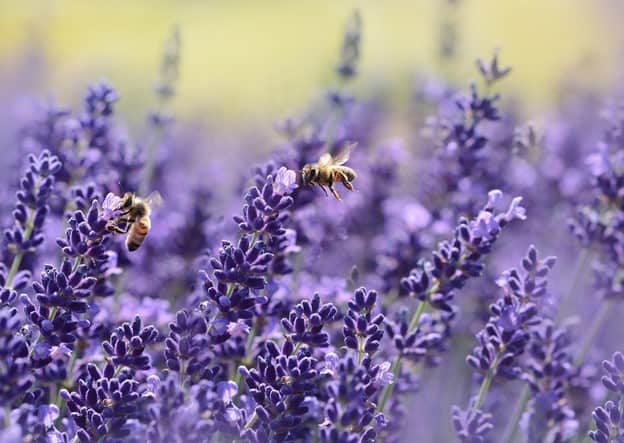Proper plant choice, nesting aids, and a strict no chemical policy can make creating a bee-friendly garden easy. Here’s how anyone can attract nature’s pollinators to their yard!
Why is a Bee-Friendly Garden Important?
“Without bees, there is no harvest” – that’s the simplest way to summarize the importance of bees for the environment. Wild bees and honeybees perform a large part of plants’ pollination, thus ensuring abundant yields and contributing to plants’ spread.

Wild Bees
Wild bees differ significantly from honeybees in several ways. Honeybees are the imported bees that we humans have been propagating for many generations. We typically raise them in hives, but sometimes they leave the hive and create new hives in the wild. This would make them feral honeybees, but still honeybees nonetheless.
Wild bees are a much more solitary creature that, unlike honeybees, do not live in a hive but may live in the ground or rock holes, plant stems, dry stone walls, or insect hotels. There are a great many varieties of wild bees, and we know much less about them than we do about our friends, the honeybees.
Because the wild bees are solitary and widespread, they have a higher pollination performance than honeybees. As a result, many plants flower better when pollinated by the more efficient wild bees. Some plant species, such as tomatoes, are pollinated exclusively by wild species.
In addition to helping our flowers bloom and our veggies grow, bees also serve as food for many other animals and are therefore crucial for the ecosystem.
How Does a Bee-Friendly Garden Help the Insects?
If the nearest wildflower meadow is very far from the bees’ nesting site, they may have trouble reaching it. Therefore, a bee-friendly garden should contain everything they need to live: It should offer them food, nesting sites, shelter, and winter quarters.
Just a few bee-friendly plants in the garden or on the balcony create such flower islands and help the bees find food. This allows the busy insects to easily fly from flower island to flower island, pollinating more plants and supporting the ecosystem. Picture a poor little bee flying around Manhattan looking for a flower. The more we can create little bee oases, the more bee-friendly our world is.
Undoubtedly, protecting the bees is essential for the earth and our well-being. Let’s look at what a bee-friendly garden looks like and which plants you should choose.

How to Make Your Garden Bee-Friendly
You can transform your plot into a bee garden with straightforward means. Even a small corner with bee-friendly plants is an excellent start for the insects. If you put in a little more effort, you can get even more out of your garden: bee-friendly perennials, herbs, and shrubs will quickly turn it into a bees’ paradise.
Drinking facilities are also necessary for bees. Fill up an empty bowl with water and place a few pebbles or marbles in it. This way, the bees can safely crawl in and out of it. Better yet, create a water garden, fountain, or pond that your bees can visit.
No Chemicals
If you are looking for the one thing you can do to encourage bees and nature of all types to thrive in your yard, it is quite simple; DO NOT USE CHEMICALS! No chemical pesticides, no chemical herbicides, nothing. I don’t care how many times the neighborhood mosquito spray guy or your landscaper tells you that the products they use are safe. They are absolutely not safe! Do not use them, ever!
Anyone who is applying these chemicals to your yard is trained by the people selling these chemicals to tell you what you want to hear so that you continue to buy more chemicals. Their jobs depend on it. Chemical corporations care about money, not bees. They will hire any scientist who will tell them what they want to hear, so plenty of scientists are available to lie to us.

Build Nesting Houses for Wild Bees
To attract wild bees to your garden, you can build so-called insect hotels – Nesting houses. They offer all sorts of bees a nice place to nest and hibernate.
You can buy such a “bee hotel” or build one yourself. If you want to build one, all you need is some wood. Build a wooden structure of any shape or size with lots of tiny holes for the bees to crawl into.
It is best to use hardwoods such as beech or oak since softwoods can easily crack and swell in damp conditions. You should also avoid resinous wood at all costs, as the resin can be deadly to insects.
Use holey wood or drill holes in the wood 3 mm to 10 mm in diameter and about 2.5 inches deep. Make sure to polish the edges of the holes so that the bees don’t harm their wings.
Finally, make it birdproof so that the birds don’t come and feast on your bees. A piece of wire mesh with holes large enough for bees of all sizes but too small for a bird to enter will work just fine.
Bee-Friendly Plants
When looking for bee-friendly garden plants, the first thing you should look for is native varieties. Bees are used to these and have learned to adapt to them. Native weeds such as Dandelions, Creeping charlie, and Beebalm are excellent nectar sources for bees and other insects such as butterflies, beetles, and moths.
Also, when choosing a plant, avoid double flower plants. These lush flowers look beautiful but make it difficult for approaching bees to find food: they have to fight through numerous petals before reaching the stamens with little to no nectar or pollen. Therefore, these flowers are not very helpful for the bees.
An easy way to have bee-friendly flowers in the garden is to use seed mixes. However, many mixes include plants from the Mediterranean or other non-native regions. The flowers are usually quite suitable for insects, but regional plants are still a better choice for native wild bees. Ideally, plant mixtures that are ideal for the insects in your area. You can obtain such plant mixtures in your local nursery or other agricultural stores.

35 Bee-friendly flowers and perennials:
- Anise hyssop/Agastache foeniculum
- Astilbe, false spirea/Astilbe spp.
- Bee balm/Monarda spp.
- Bellflower/Campanula spp.
- Black-eyed Susan, coneflower/Rudbeckia spp.
- Blazing star/Liatris spicata
- Butterfly bush/Buddleja or Buddleia spp.
- Catmint/Nepeta spp.
- Chrysanthemum (open types)/Chrysanthemum
- Clematis/Clematis spp.
- Common yarrow/Achillea millefolium
- Coral bells/Heuchera spp.
- Cornflower/Centaurea spp.
- Fennel/Foeniculum vulgare
- Foxglove or beardtongues/Penstemon spp.
- Garden speedwell/Veronica longifolia
- Globe thistle/Echinops ritro
- Hosta/Hosta spp.
- Hyssop (naturalized in North America)/Hyssopus officinalis
- Large-leaved aster/Eurybia macrophylla
- Lavender/Lavandula
- Lupine/Lupinus spp.
- Mints/Mentha spp.
- Oregano/Origanum vulgare
- Pentas/Pentas spp.
- Peony/Paeonia spp.
- Pincushion flower/Scabiosa caucasica
- Rosemary/Rosmarinus officinalis
- Russian sage/Perovskia atriplicifolia
- Sea holly/Eryngium maritimum
- Stokes aster/Stokesia laevis
- Sunflower/Helianthus
- Swamp milkweed/Asclepias incarnata
- Sweet alyssum/Lobularia maritima
- Thyme/Thymus spp.
Be Friendly to the Bees!
It’s no news that bees are in trouble. Some varieties have been declining steadily for a long time. Agriculture specializing in monocultures deprives bees of their habitat and food base. Without bees doing a large part of the pollination, we would not have a functioning ecosystem.
We can all contribute to saving the bees by merely making our backyards a bit more bee-friendly.
A bee-friendly garden offers safe nesting, shelter, water sources, and a wide variety of food. This means an area free of deadly chemicals. It’s not all about the bees; it’s about us. We need to care for our earth, and these tiny little buzzing pollinators are a crucial part of our world. Plant some pretty flowers, make your yard beautiful and help the bees.

